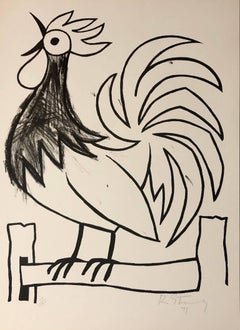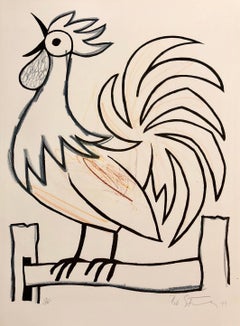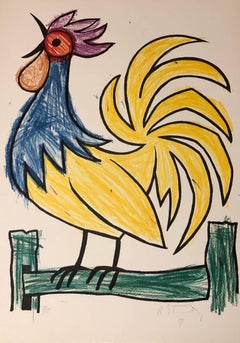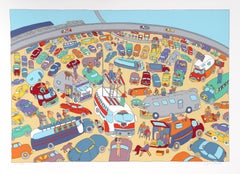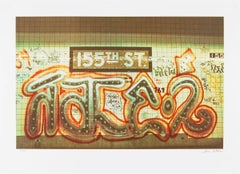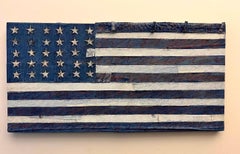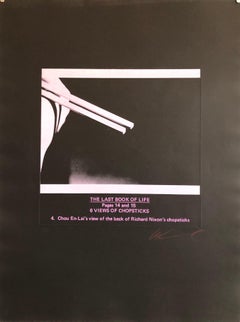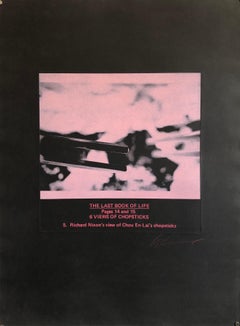1970s Pop Art
1970s Pop Art Animal Prints
Lithograph, Screen
1970s Pop Art Animal Prints
Lithograph, Screen
1970s Pop Art Animal Prints
Lithograph, Screen
1970s Pop Art More Prints
Screen
1970s Street Art Color Photography
Screen
21st Century and Contemporary Pop Art Color Photography
Archival Paper, Photographic Paper
20th Century Pop Art Mixed Media
Cotton, Cotton Canvas, Found Objects, Mixed Media
1970s Conceptual Abstract Prints
Etching, Photogravure
1970s Conceptual Abstract Prints
Etching, Photogravure
1970s Conceptual Abstract Prints
Etching, Photogravure
1970s Conceptual Abstract Prints
Etching, Photogravure
1970s Street Art Color Photography
Screen
1970s Street Art Color Photography
Screen
1970s Street Art Color Photography
Screen
1970s American Modern Portrait Prints
Screen
1970s Conceptual Abstract Prints
Etching, Photogravure
1970s American Modern Abstract Prints
Screen
1970s Pop Art Figurative Prints
Lithograph, Offset
1970s Pop Art Nude Paintings
Oil, Canvas
1970s Pop Art Prints and Multiples
Screen
1970s Pop Art More Art
Paper, Offset
1970s Pop Art Nude Prints
Screen, Paper
1970s Pop Art Mixed Media
Canvas, Magazine Paper
1980s Pop Art Abstract Prints
Screen
1980s Pop Art Abstract Prints
Screen
1970s Arte Povera Figurative Sculptures
Wood, Paper
20th Century Pop Art Abstract Prints
Lithograph
1970s Pop Art Figurative Prints
Paper, Offset
1970s Pop Art Figurative Sculptures
Mixed Media
1970s Pop Art Figurative Paintings
Canvas, Oil
1970s Pop Art Figurative Prints
Offset
1970s Assemblage Color Photography
Mixed Media, Newsprint, Photographic Paper
1970s Abstract Geometric Abstract Prints
Screen
21st Century and Contemporary Pop Art Prints and Multiples
Offset
Late 20th Century Realist Figurative Prints
Screen
1970s Pop Art Abstract Paintings
Canvas, Acrylic, Laid Paper, Permanent Marker
2010s Pop Art Sculptures
Paper
1970s Contemporary Abstract Paintings
Canvas, Acrylic
1970s Pop Art Abstract Prints
Screen
1970s Pop Art Abstract Prints
Screen
1970s Pop Art Figurative Prints
Lithograph
1970s Pop Art Figurative Prints
Offset
1970s Pop Art Prints and Multiples
Lithograph, Offset
1970s Pop Art Figurative Prints
Lithograph
1970s Abstract Abstract Prints
Lithograph
1970s Pop Art Figurative Prints
Lithograph
1970s Abstract Geometric Abstract Prints
Pencil, Lithograph
1970s Pop Art Prints and Multiples
Lithograph
1970s Pop Art Figurative Prints
Lithograph
1970s Pop Art Figurative Prints
Lithograph
1970s Pop Art Figurative Prints
Offset
21st Century and Contemporary Pop Art Color Photography
Mixed Media, Archival Paper, Digital
1970s Pop Art Figurative Prints
Canvas, Color
1970s Pop Art Abstract Prints
Lithograph, Offset
1970s Pop Art Abstract Prints
Paper, Screen
1970s Pop Art Black and White Photography
C Print
1970s Pop Art Landscape Drawings and Watercolors
Oil
1970s Pop Art Figurative Drawings and Watercolors
Watercolor
1970s Pop Art Figurative Prints
Lithograph, Offset
1970s Pop Art Figurative Drawings and Watercolors
Paper, Carbon Pencil
- 1
1970s Pop Art For Sale on 1stDibs
How Much is a 1970s Pop Art?
- What is Pop art?1 Answer1stDibs ExpertSeptember 25, 2019
Pop art is a movement, started in the 1950s, that uses imagery from popular culture.
- What does pop art mean?2 Answers1stDibs ExpertFebruary 22, 2021Pop art refers to a movement that emerged during the mid- to late-1950s. It is art based on popular culture and mass media and works to critique traditional fine art values. Find many different works under the Pop art category on 1stDibs.Irena Orlov ArtMarch 1, 2021It emerged in 1950 in United States and England. It is characterized by using images as objects of popular culture or everyday life, obtained from the media. Through irony, it reflected the society of the time, marked by consumerism, materialism, the cult of image and fashion.
- Who was the founder of Pop art?1 Answer1stDibs ExpertAugust 15, 2024There was no single founder of Pop art, as many artists contributed to the development of the movement. Richard Hamilton’s 1956 collage Just what is it that makes today’s homes so different, so appealing? is widely believed to have kickstarted the unconventional new style. Although Hamilton and other British artists launched the movement, they were soon overshadowed by their American counterparts.
Pop art is perhaps most closely identified with American artist Andy Warhol, whose clever appropriation of motifs and images helped to transform the artistic style into a lifestyle. Roy Lichtenstein was another prominent American Pop artist. Much like Warhol, Lichtenstein drew his subjects from print media, particularly comic strips, producing paintings and sculptures characterized by primary colors, bold outlines and halftone dots, elements appropriated from commercial printing. On 1stDibs, shop a range of Pop art. - What is British Pop art?1 Answer1stDibs ExpertMay 14, 2024British Pop art is a style of art that emerged in the United Kingdom during the 1950s. British artist Richard Hamilton's 1956 collage Just what is it that makes today's homes so different, so appealing? is widely believed to have kickstarted this unconventional new style, which reacted to the period's consumerism. Its goal was to put popular culture on the same level as so-called high culture. Although British artists launched the Pop art movement, they were soon overshadowed by their American counterparts. Pop art is perhaps most closely identified with American Pop artist Andy Warhol, whose clever appropriation of motifs and images helped to transform the artistic style into a lifestyle. On 1stDibs, shop a wide range of Pop art.
- What influenced Pop Art?1 Answer1stDibs ExpertSeptember 25, 2019
Pop art was influenced by advertising and other forms of mass marketing
- Is Pop Art postmodern?1 Answer1stDibs ExpertSeptember 25, 2019
Yes, Pop art is considered postmodern.
- Why is it called Pop art?1 Answer1stDibs ExpertNovember 26, 2024The reason why it is called Pop art is that artists who participated in the movement drew inspiration from popular, or "pop," culture. One of the most influential contemporary art movements, Pop art emerged in the 1950s. Its practitioners sought to challenge the status quo, breaking with the perceived elitism of the previously dominant Abstract Expressionism and making statements about current events. They drew on imagery from popular culture — comic books, advertising, product packaging and other commercial media — to create original Pop art paintings, prints and sculptures that celebrated ordinary life in the most literal way. Pop art works are distinguished by their bold imagery, bright colors and seemingly commonplace subject matter. On 1stDibs, shop a wide variety of Pop art.
- Who is the father of Pop art?1 Answer1stDibs ExpertApril 16, 2024Opinions vary on who the father of Pop art may be. Pop art emerged in the 1950s in Britain and flourished in 1960s-era America as a reaction to postwar mass consumerism. Some argue that Andy Warhol deserves the title because he helped shape the movement during the 1960s. However, other artists like Eduardo Paolozzi and Richard Hamilton began producing what’s now considered Pop art a decade earlier. Other artists who made important contributions to Pop art include Marta Minujín, Claes Oldenburg, Rosalyn Drexler, James Rosenquist, Peter Blake and Roy Lichtenstein. On 1stDibs, shop a selection of Pop Art.
- Why did Pop art start?1 Answer1stDibs ExpertFebruary 13, 2024Pop art started because artists sought to react to the mass consumerism of the 1950s with the goal of putting popular culture on the same level as so-called high culture. Works associated with Pop art are distinguished by their bold imagery, bright colors and seemingly commonplace subject matter. Practitioners endeavored to challenge the status quo. Pop artists broke with the perceived elitism of the previously dominant Abstract Expressionism and made pointed statements about current events. Richard Hamilton's 1956 collage ‘Just what is it that makes today’s homes so different, so appealing?’ is widely believed to have kickstarted this unconventional new style, but Pop art is perhaps most closely identified with American Pop artists Andy Warhol and Roy Lichtenstein. On 1stDibs, explore a collection of Pop art.
- 1stDibs ExpertSeptember 25, 2019
Andy Warhol is one of the most famous Pop artists.
- 1stDibs ExpertFebruary 13, 2023The bright colors and graphic patterns and imagery of Pop art continue to influence fashion, prompting the industry’s designers to integrate provocative color pairings and visuals commonly associated with mass media and advertising into their garments. You can see examples of this in iconic pieces by Pierre Cardin, Mary Quant and Vivienne Westwood as well as in the work of many contemporary designers. Specifically, the well-known portraits that Andy Warhol created of celebrities and pop culture figures made their way into fashion by designers who incorporated images of popular celebrities into their clothing designs.
- 1stDibs ExpertApril 22, 2024Opinions vary as to what the most famous piece of Pop art is. Two major contenders for the title are Andy Warhol's 1961–62 series Campbell's Soup Cans and Roy Lichtenstein's 1963 diptych painting Whaam!. Other notable Pop art works include A Bigger Splash by David Hockney, Flag by Jasper Johns, Crying Girl by Roy Lichtenstein, Radiant Baby by Keith Haring, the Marilyn Triptych by Andy Warhol, and Spoonbridge and Cherry by Claes Oldenburg. On 1stDibs, find a wide range of Pop art.
- 1stDibs ExpertMay 3, 2024Who is considered the father of Pop art is open for debate. Some experts give the title to Andy Warhol, whose clever appropriation of motifs and images helped to transform the artistic style into a lifestyle. Others may argue that Roy Lichtenstein deserves the credit, as his work drawing from print media helped to define the style. Another potential candidate is Richard Hamilton, whose 1956 collage Just what is it that makes today's homes so different, so appealing? is widely believed to have kickstarted the Pop art movement. Shop a diverse assortment of Pop art on 1stDibs.
- 1stDibs ExpertSeptember 25, 2019Artists in the United Kingdom started the Pop art movement as a reaction, both positive and critical, to the period's consumerism. Its goal was to put popular culture on the same level as so-called high culture. London-born artist Richard Hamilton is widely believed to have had a pioneering role in Pop art, which drew on imagery from popular culture - comic books, advertising, product packaging and other commercial media - to create paintings and sculptures that celebrated ordinary life in the most literal way. Although British artists launched the movement, they were soon overshadowed by their American counterparts. Andy Warhol, Roy Lichtenstein and Rosalyn Drexler are some of the American artists associated with the history of Pop art. Find original Pop art on 1stDibs.
- What was worn in the 1970s?1 Answer1stDibs ExpertFebruary 22, 2021Fashion during the 1970s included lots of T-shirts, cardigans, kimonos, graphic tees, jeans, khakis, and vintage clothes. In the mid-1970s, other fashion highlights included puffy skirts and shirts with flowy sleeves.
- Is Alex Katz's style Pop art?1 Answer1stDibs ExpertMay 3, 2024Yes, Alex Katz's style is Pop art. During the 1950s, he experimented with collage and painting on aluminum sheets, with his later work in the 1960s drawing inspiration from film and advertising. In the 1970s, Katz expanded into portrait groups that regularly depicted the cultural scene of New York. In the 1980s, he extended his focus to fashion and its supermodels. These sources of inspiration align with Pop art's focus on transforming elements of popular culture into fine art. On 1stDibs, shop a collection of Alex Katz art.
- 1stDibs ExpertMarch 22, 2022Roy Lichtenstein painted Pop art to comment on geopolitical and social issues of his time. He patterned his work off of mass media like advertising and comic books to help convey his messages. On 1stDibs, shop a range of Roy Lichtenstein art.
- 1stDibs ExpertMarch 22, 2022Roy Lichtenstein started producing Pop art in the 1950s. His work drew inspiration from advertisements and comic books. In the 1960s, his work became widely known, and today, historians credit him with greatly influencing the Pop art movement. On 1stDibs, find a collection of Roy Lichtenstein art.
- 1stDibs ExpertApril 5, 2022Yes, sequins were indeed popular in the 1970s and could be seen on the dancefloors and discos of the time, along with other popular fabrics like velvet and satin. Sequins and hot pants were the go-to outfit of the disco-glam decade. Shop iconic vintage and contemporary sequin clothing from some of the world’s top boutiques on 1stDibs.
- Was velvet used in the 1970s?1 Answer1stDibs ExpertJune 15, 2023Yes, velvet was used in the 1970s. Fashion designers used the fabric to produce dresses, bell bottoms, flowy kimonos and other pieces. Furniture makers often used it as the upholstery on sofas and armchairs. On 1stDibs, shop a variety of pieces from the 1970s.
